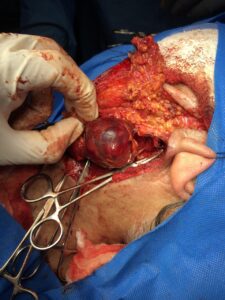Laparoscopic Supracervical Abdominal Hysterectomy LSH for large uterine MYOMA (Mar.2020)
Case presentation
39 year old female patient presented with large uterine myoma. She had complete her family and wish to do hysterectomy without removing her cervix. The patient was checked by gynecologist for the condition of vagina and cervix which were normal. The patient prepared for surgery and thromboprophylaxis measures were taken plus prophylactic antibiotic was taken one hour preoperatively.
3 ports laparoscopic partial supracervical hysterectomy in Trendelenburg position was done.
The uterus was removed and extracted via small Pfannestiel incision. The histopathological results was uterine myoma.
The postoperative course was smooth and the patient discharged in 2nd postoperative day.
Review of literature
Laparoscopic Supracervical Hysterectomy: a Retrospective Analysis of 1000 Cases
Bernd Bojahr, PhD,corresponding author Garri Tchartchian, MD, and Ralf Ohlinger, PhD
Author information Copyright and License information Disclaimer
This article has been cited by other articles in PMC.
Abstract
Objective:Laparoscopic supracervical hysterectomy (LASH) was analyzed with regard to surgical indications and outcomes.
Methods:
This is a retrospective analysis of the first 1,000 consecutive laparoscopic supracervical hysterectomies performed by one gynecologist from September 1, 2002 to April 30, 2006. The objective of the study was to find out to what extent the indication and the outcome of surgery changed with the increase in experience of the surgeon and whether a learning curve could be established based on the results. The demographic patient data, indication for surgery, patient history with regard to previous surgery, duration of surgery, intraoperative complications, uterus weight, and length of in-patient stay were collected from the medical records.
Results:
The main indication in 80.4% of cases was uterus myomatosis. The median duration of surgery was 70.9±26.3 minutes (95% CI, 69.2 to 72.5) with an average uterus weight of 212.5±177.0g (95% CI, 201 to 223.6). This was reduced from 85.4±25.9 minutes (95% CI, 78.5 to 92.3) in 2002 to 72.4±30.1 minutes (95% CI, 66.7 to 78.2) in 2006, in conjunction with an increase in average uterus weight from 192.3±145.4g (95% CI, 153.8 to 230.9) to 228.7±160.3g (95% CI, 198.1 to 259.3). Overall, one intraoperative lesion of the bladder (0.1%) occurred, and in 4 cases the surgeon had to convert to laparotomy instead, due to the size and immobility of the uterus. Sixty-eight patients had a uterus weight of more than 500 g. In 67% of the cases, surgery was performed on patients with at least one previous laparotomy, and 51.4% of the patients required further interventions.
Conclusion:
An experienced surgeon can rapidly learn the technique of laparoscopic supracervical hysterectomy and can safely perform it. In patients with symptomatic uterine myomatosis, previous laparotomy and/or with a uterine weight of more than 500g, laparoscopic supracervical hysterectomy is a useful alternative to total hysterectomy. There are few complications if preservation of the cervix is not contraindicated.
Keywords: Laparoscopic supracervical hysterectomy





